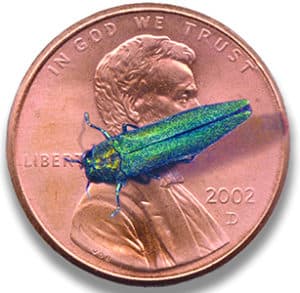
Adult emerald ash borer (EAB)
By Gary Salmon
There is a line in the lyrics of this great Bee Gees song of the ‘70s that if I were an ash tree and John Travolta was singing it to me I would pay attention to: “Life goin’ nowhere, somebody help me.”
Since emerald ash borer (EAB) began infecting Vermont ash trees in 2018 there has been a slow but steady expansion of this insect’s work measured in “infested areas” and dead ash trees all over Vermont. Only actual ash trees need to heed these lyrics (genus Fraxinus) as mountain ash is not actually an ash at all (genus Sorbus) and can listen to the song with immunity from its implications.
Our sense of “helping out” our ash trees changed last fall when an EAB outbreak was located in West Rutland. “Somebody help me” if you are a white, green, or black ash in the in infested area or the resulting adjacent “high risk area” (within 10 miles of an outbreak) like Shrewsbury, Killington, or other adjacent towns. Natural immunity of any Vermont ash which will keep them alive once this borer is established in an area is microscopically low.

Adult EABs are only ½-inch long and can fit on the head of a penny.
So what to do?
Use your eyes this summer and begin by learning what an ash looks like as well as the emerald ash borer. Trees are identified by leaves, bark, buds, leaf arrangement, and seeds and there are countless tree ID books to find ash trees in. Look carefully at several of the characteristics to increase the likelihood of what you are looking at actually being an ash. There are also phone apps like LeafSnap-Plant Identification that will identify any tree that you “phone photograph” and compare to the app.
Borers are bright green, and only ½” long and 1/8” wide. Early EAB detection is crucial to slow the spread but also very difficult as the first signs (and most important ones) are crown decline and dieback. Later as the infestation increases more obvious signs become evident: bark cracking along the trunk, clear evidence of woodpecker feeding on the larvae, bark sloughing off (exposing white segmented larvae in “S” shaped galleries), leaves in clumps on the crown, and very small “D” shaped holes where these very small borers have emerged.

EAB larvae tunnel and feed just under the tree’s bark, the cambium level, leaving paths of destruction.
Found possible signs of EABs, now what?
Don’t be shy and if you think it is EAB contact VTinvasives.com or the USDA Animal and Plant Health Inspection Service (APHIS) hotline at: 1-866- 322-4512.
“Somebody help me” will work because ash trees can be saved with an every other year inoculation of emamectin benzoate injected by an arborist with a certified pesticide applicators license. Rough costs are $12-$15/diameter inch (circumference divided by 3.14) and there is a statewide list of companies (Google “ash tree protective services contact list”) that can do the work. Locally these include Bartlett Tree Experts (Manchester and White River Junction); Trees Incorporated (Rutland); Limbwalker Tree Services (Weybridge); Henderson Tree Service (White River Junction) and Timber Tenders in Woodstock. Any ash in good health, located within at least a “high risk area,” worthy of protection, and less than 30% infested can be a candidate and while it may be cost prohibitive to inoculate all ash trees it is certainly a choice for any landowner or community to do so.
Stayin’ alive is an unlikely option if you are an ash tree in Vermont without somebody helping out.




